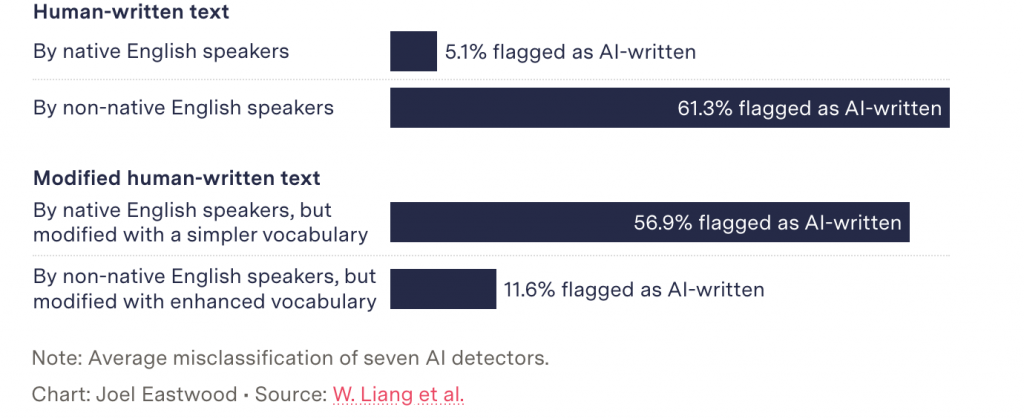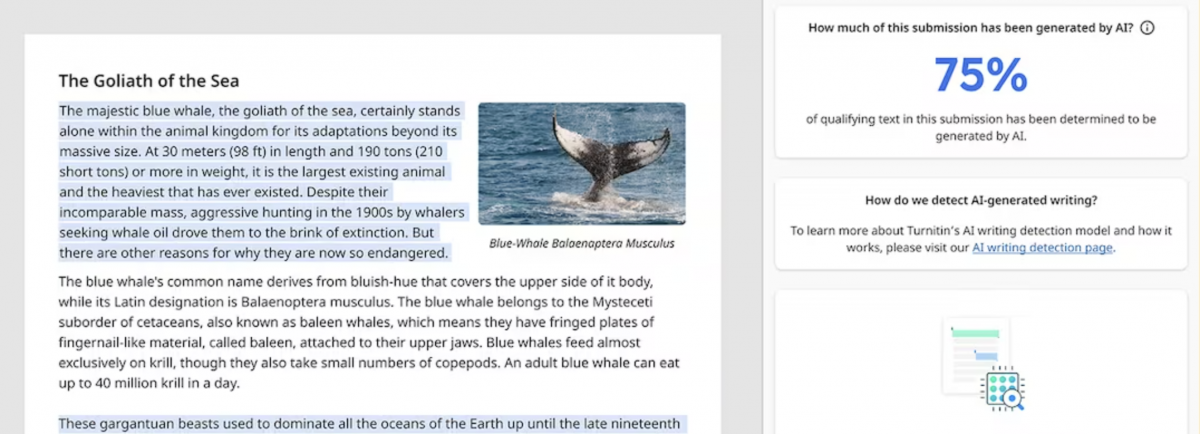The rise of generative AI tools such as Chat-GPT has changed the face of education forever. Due to concerns about using AI-generated texts for essays or thesis, AI-detection tools have quickly become a standard in plagiarism, as teachers try their best to navigate a technological advancement that seemed inconceivable only as little as a year ago. However, these tools do not come without their own concerns.
The accuracy of AI-detection tools such as Turnitin have been called into question numerous times – the company initially claimed the tool had a 1% false positive rate, however, later reported the false positive rates were higher than intially reported, without offering new numerical estimates (Chechitelli, 2023). This would mean that, for example, assuming each of ca. 30,000 Erasmus University students submits an essay, 300 of them would get falsely accused of plagiarism. While the 1% risk may not seem high, being falsely accused of plagiarism could mean disastrous consequences such as barring those 300 students from all exams for up to one year, delaying ones study progress (Erasmus University, 2023). Accusing a student of plagiarism due to a false positive has other substantial risks, such as potentially facing “loss of student trust, confidence and motivation, bad publicity, and potential legal sanctions“ (University of Pittsburgh, 2023).
Recently published research raised an alarming concern – GPT detectors are more likely to misclassify the writings of non-native English speakers as AI-generated, as native writing often uses a wider vocabulary, and is deemed as more “human” by AI-detecting software (Liang et al, 2023). This raises additional concerns on the bias against non-native English speakers in an educational setting.

As universities rely more and more on AI detection tools, it remains crucial for educators and students alike to consider the shortcomings of AI-detection tools, and make sure not to run to any accusations or conclusions. In fact, many top educational institutions, such as Vandebilt University, have “decided to disable Turnitin’s AI detection tool for the foreseeable future”, due to concerns and questions about its detection methods and accuracy, and the harmful implications of false accusations on their students (Vanderbilt University, 2023).
Using AI detection tools remains a divisive topic. While Turnitin’s CPO is set on improving its detection systems, some AI scientists argue that AI detection tools have no place in education due to their high error rates (Washington Post, 2023). Either way, the use of AI is here to stay in education – it remains up to institutions whether they decide to endorse generative AI detection tools despite its shortcomings and substantial risks.
References
Coley, M. (2023). Guidance on AI detection and why we’re disabling Turnitin’s AI detector. Vanderbilt University. Retrieved from https://www.vanderbilt.edu/brightspace/2023/08/16/guidance-on-ai-detection-and-why-were-disabling-turnitins-ai-detector/
Chechitelli, A. (2023). Understanding the false positive rate for sentences of our AI writing detection capability. Retrieved from https://www.turnitin.com/blog/understanding-the-false-positive-rate-for-sentences-of-our-ai-writing-detection-capability
Erasmus University Rotterdam (2023). Cheating and plagiarism in assignments, theses and exams. Retrieved from https://www.eur.nl/en/media/85025.
Liang, W., Yuksekgonul, M., Mao, Y., Wu, E., & Zou, J. (2023). GPT detectors are biased against non-native English writers. Patterns (New York, N.Y.), 4(7), 100779. https://doi.org/10.1016/j.patter.2023.100779
University of Pittsburgh. (2023). Teaching Center doesn’t endorse any generative AI detection tools. Retrieved from https://www.utimes.pitt.edu/news/teaching-center-doesn-t
Washington Post. (2023). What to do when you’re accused of AI cheating. Retrieved from https://www.washingtonpost.com/technology/2023/08/14/prove-false-positive-ai-detection-turnitin-gptzero/





